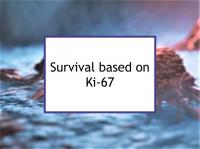Below we summarize data published during the last 14 years concerning the relationship between Ki-67 and risk of breast cancer recurrence. However, please note that individual outcomes can vary depending on numerous factors and the data below represents snapshots from studies that were conducted under a variety of circumstances.
Furthermore, most studies that calculate survival do not present the results as simple percentages. Therefore, the numbers below are somewhat inconsistent and far from complete or definitive and should not be used to calculate your likelihood of recurrence-free survival. However, the data is useful in getting a general idea of how Ki-67 relates to prognosis.
Definition of terms
Ki-67 (or Ki67) is a measure of the proliferative activity of breast cancer cells. It is an assessment of the proportion of the tumor cells that are growing and dividing, rather than in the resting phase of the cell growth cycle. As such, it is one marker of tumor aggressiveness. Ki-67 normally can be found on breast cancer pathology reports.
Progression-free survival means that no recurrence, metastasis or breast cancer-related death took place during the specified period.
Ki-67-related progression-free survival data
Patient and Ki-67 characteristics → Likelihood of 5-year progression-free survival
Based on proliferation level (Ki-67) alone
- Low proliferation, defined as Ki-67 < 10%
- Low: Ki-67 < 10% → 90%
- Intermediate: Ki-67 10% to 19% → 89%
- High: Ki-67 ≥ 20% → 77%
- Low proliferation, defined as < 15%
- Low: Ki-67 < 15% → 87%
- Intermediate: Ki-67 15% to 45% → 77% to 83%
- High: Ki-67 > 45% → 76%
Proliferation plus additional breast cancer characteristics
- ER+/PR+ receptor status, postmenopausal
- ER+/PR+/HER2- Postmenopausal, low Ki-67 (< 10%) → 98%
- ER+/PR+/HER2- Postmenopausal, high Ki-67 (≥10%) → 90% to 94%
- ER+/PR+ receptor status, stage II
- ER+/PR+/HER2- Stage II, low Ki-67 (< 10%) → 84%
- ER+/PR+/HER2- Stage II, intermediate Ki-67 (10% to 19%) → 88%
- ER+/PR+/HER2- Stage II, high Ki-67 (≥ 20%) → 79%
- Luminal A or luminal B
- Residual tumor burden
- ER+/PR+/HER2- Ki-67 > 13%, no pathologic complete response → 84%
- ER+/PR+/HER2- Ki-67 > 13%, pathologic complete response → 92%
- Triple negative (ER-/PR-/HER2-) tumor
- ER-/PR-/HER2- Ki-67 ≤ 40% → 91% three-year progression-free survival
- ER-/PR-/HER2- Ki-67 > 40% → 78% three-year progression-free survival
Below are links to studies on this topic. Please also see our article on Ki-67, which describes factors that drive proliferation.
